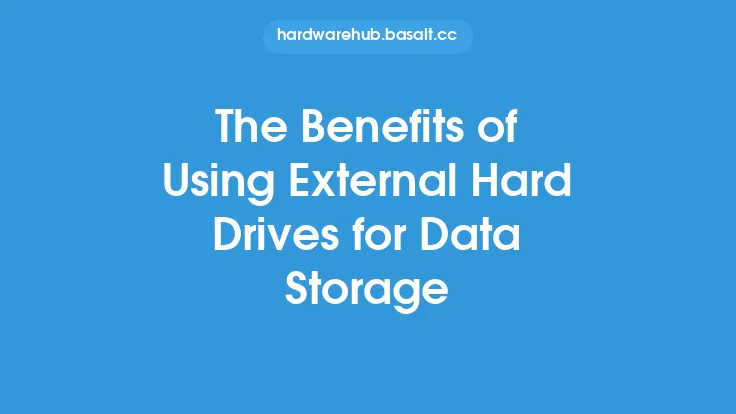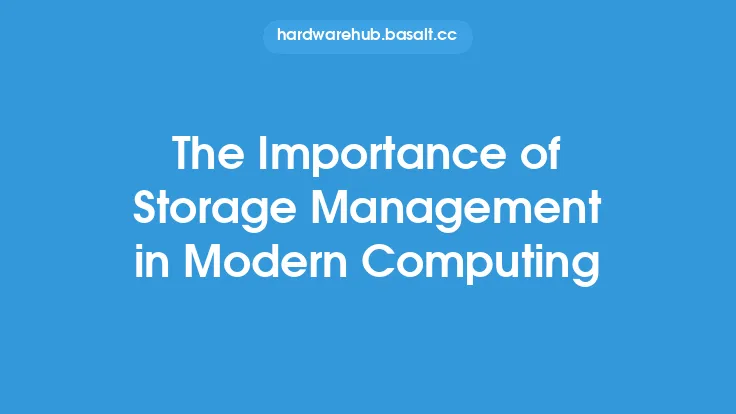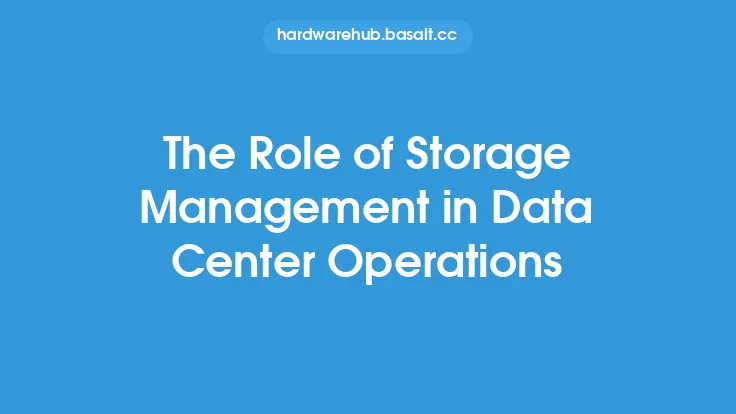As enterprises continue to generate and store vast amounts of data, the need for efficient and effective storage management has become increasingly important. One key strategy that has emerged in recent years is automated storage management, which uses advanced software and hardware to optimize storage resources and improve overall system performance. In this article, we will explore the benefits of automated storage management for enterprises, including its ability to simplify storage administration, improve data protection, and reduce costs.
Introduction to Automated Storage Management
Automated storage management refers to the use of software and hardware to automate various aspects of storage management, including data placement, replication, and retrieval. This can include technologies such as storage virtualization, data deduplication, and automated tiering, which work together to optimize storage resources and improve system performance. By automating many of the manual tasks associated with storage management, enterprises can free up IT staff to focus on more strategic initiatives and improve overall system efficiency.
Benefits of Automated Storage Management
There are several key benefits to automated storage management, including simplified storage administration, improved data protection, and reduced costs. By automating many of the manual tasks associated with storage management, enterprises can reduce the risk of human error and improve overall system reliability. Additionally, automated storage management can help to improve data protection by ensuring that data is properly replicated and backed up, and that it can be quickly recovered in the event of a disaster. Finally, automated storage management can help to reduce costs by optimizing storage resources and reducing the need for manual intervention.
Key Features of Automated Storage Management
There are several key features of automated storage management, including storage virtualization, data deduplication, and automated tiering. Storage virtualization refers to the ability to abstract storage resources from the underlying hardware, allowing for more efficient use of storage capacity and improved system flexibility. Data deduplication refers to the ability to eliminate duplicate copies of data, reducing storage capacity requirements and improving system efficiency. Automated tiering refers to the ability to automatically move data between different storage tiers, based on factors such as data usage and performance requirements.
How Automated Storage Management Works
Automated storage management works by using advanced software and hardware to monitor and optimize storage resources in real-time. This can include using sensors and analytics to monitor storage usage and performance, and using automated workflows to optimize data placement and replication. Additionally, automated storage management can use machine learning and artificial intelligence to predict storage usage and performance, and to make recommendations for optimization. By using these advanced technologies, enterprises can improve overall system efficiency and reduce the risk of human error.
Best Practices for Implementing Automated Storage Management
There are several best practices for implementing automated storage management, including starting with a thorough assessment of storage resources and usage patterns. This can help to identify areas for optimization and ensure that the automated storage management system is properly configured. Additionally, enterprises should ensure that they have the necessary skills and expertise to implement and manage the automated storage management system, and that they have a clear understanding of the system's capabilities and limitations. Finally, enterprises should ensure that they have a comprehensive plan in place for monitoring and maintaining the automated storage management system, to ensure that it continues to operate effectively over time.
Common Challenges and Limitations
While automated storage management can offer many benefits, there are also several common challenges and limitations to consider. One of the main challenges is the complexity of implementing and managing the system, which can require significant expertise and resources. Additionally, automated storage management can be expensive, particularly for large-scale enterprises with complex storage environments. Finally, there may be limitations to the system's ability to optimize storage resources, particularly in environments with highly variable or unpredictable storage usage patterns.
Future of Automated Storage Management
The future of automated storage management is likely to be shaped by several key trends, including the increasing use of cloud-based storage and the growing importance of artificial intelligence and machine learning. As more enterprises move to the cloud, there will be a growing need for automated storage management systems that can optimize storage resources across multiple cloud providers and environments. Additionally, the use of artificial intelligence and machine learning will become increasingly important, as enterprises seek to improve the efficiency and effectiveness of their automated storage management systems. By staying ahead of these trends, enterprises can ensure that they are well-positioned to take advantage of the benefits of automated storage management, and to improve overall system efficiency and performance.
Conclusion
In conclusion, automated storage management is a powerful strategy for optimizing storage resources and improving overall system performance. By automating many of the manual tasks associated with storage management, enterprises can simplify storage administration, improve data protection, and reduce costs. While there are several common challenges and limitations to consider, the benefits of automated storage management make it an essential consideration for any enterprise seeking to improve its storage management capabilities. By understanding the key features and benefits of automated storage management, and by following best practices for implementation and management, enterprises can ensure that they are well-positioned to take advantage of this powerful technology and improve overall system efficiency and performance.





